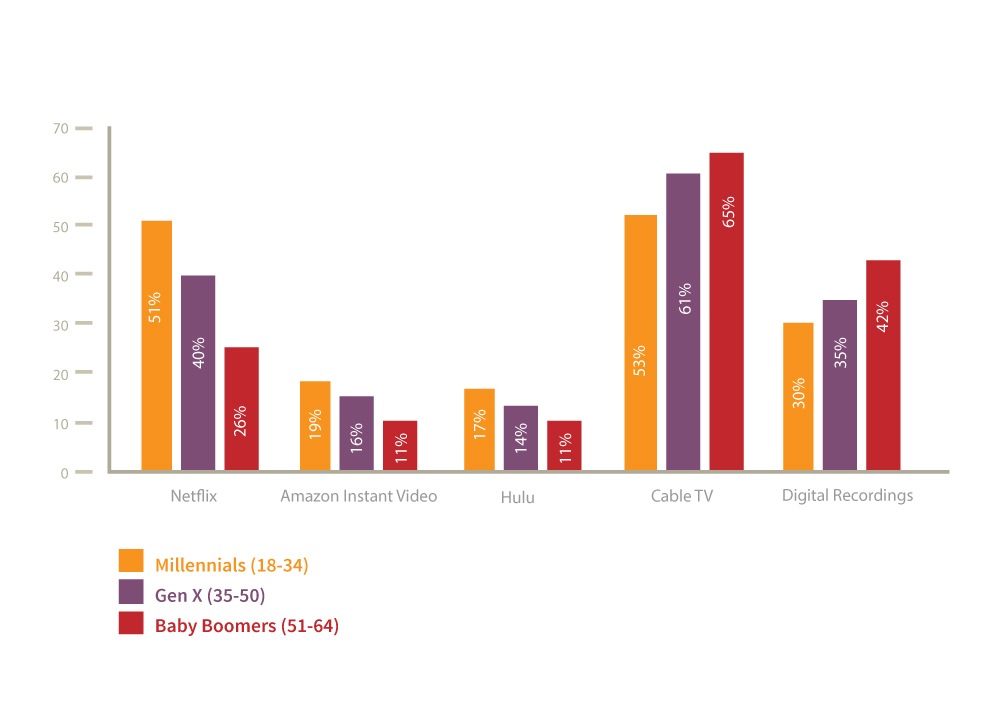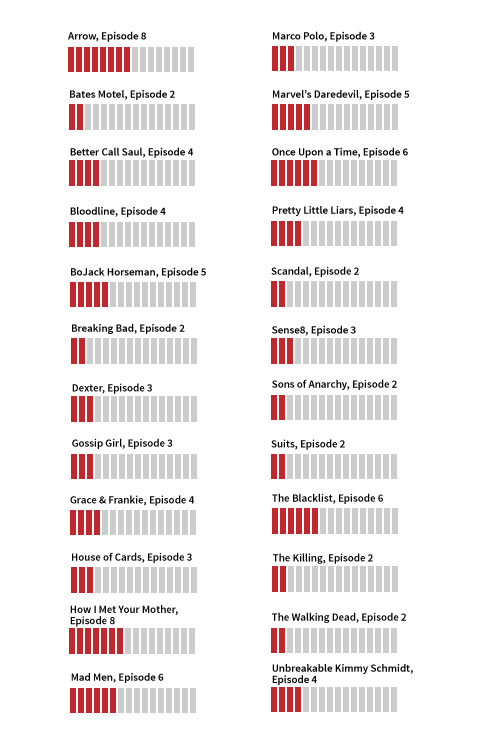The act of binge watching has officially become a pop culture phenomenon. People are watching episode after episode after episode. In fact, they’re watching so many episodes that the idea of finishing an entire series in one weekend is no longer far-fetched. Instead, it’s become the new normal.
So, what exactly classifies as binge watching? According to Netflix, it’s watching two to six episodes of the same show in one sitting, and nine of 10 people admit they’ve done it. What’s more, 73 percent say they have positive feelings about it.
9 out of 10 people admit to binge watching.
Why has binge watching become so popular, you ask? Reasons for binge watching vary, but Netflix found two in three people say there’s simply too much good TV to watch. (No argument there, right?)
Where are people binge watching?
About two in five American households now subscribe to a video streaming service, and people in those households spend a significant amount of time in front of their screens. Some households have even chosen to dive into streaming completely—becoming “broadband only” homes. It’s estimated that 2.6 million don’t subscribe to cable at all, but rely solely on streaming.
2.6 million households rely solely on a video streaming service.
Here’s where users are tuning in to TV:
- Netflix. Home to 60 million subscribers who spend approximately 10 billion hours each month using the service, 66 percent admit to binge watching shows at least every few weeks.
- Amazon Instant Video. Approximately 25 million people use Amazon Instant Video to stream more than 17,000 movies and TV shows.
- Hulu. A slightly smaller streaming service with nine million users. The average user spends approximately one hour and 13 minutes on site every time they visit.
- Cable TV. In 2014, more than 39 million people were still subscribed to cable, reaping the benefits of more than 900 channels to choose from. However, the number of cable viewers—especially during live TV—is on the decline.
- Digital Recordings. More and more viewers are using DVRs and on-demand services to watch TV after its live airing. Fifty-three percent of viewers watch this type of “time shifted” content, totaling 14 hours and 20 minutes per month, per person.
Who’s using these services?
Streaming here, streaming there, streaming everywhere. Binge watching is becoming consistent across all generations, but Millennials tend to be leading the way. They’re continuously consuming TV shows and videos on their time, not the networks’. And as a result, they’re almost two times more likely than other generations to watch something later than to watch it live.

More than half of all Netflix subscribers are Millennials.
What are people binge watching?
Drama? Check. Fifty-four percent of people in a recent survey say they love powering through those hour-long episodes, especially women.
Comedy? Another check. They’re usually shorter, which makes it easier to watch more episodes. And when it comes to chuckles, Millennials are on board. Twenty percent will binge watch for belly laughs, and 57 percent will go to Netflix first to find them, especially men.
Thus, it comes as no surprise that “Breaking Bad,” “Dexter,” “Game of Thrones,” “The Walking Dead” and “Orange is the New Black” are among the top five shows recommended to binge watchers. (Although if you ask me, I’d say: “One Tree Hill,” “Friends,” “The Big Bang Theory,” “Boy Meets World” and “Parenthood.”)
But, what does come as a surprise is that Netflix now knows precisely which episode makes viewers addicted to a TV series… and it’s usually not the pilot. Maybe that’s why the idea of releasing an entire series at one time has become their go to. For Netflix, the thought of getting people to come back week after week is hard. But the idea of getting them hooked on an entire series—so much so that they watch it in its entirety in one sitting—that’s easy.

How can marketers connect?
As audiences continue to shift away from traditional viewing methods, how can marketers reach them in meaningful ways? And to that, we ask, why not meet them where they are?
- Product placement. In 2011, “The Big Bang Theory” shot a scene in which Sheldon was playing a prank on Raj by putting a live snake in his desk drawer. Immediately after doing so, Sheldon—the loveable germaphobe that he is—started repeating, “Oh dear, oh dear, oh dear. Purell. Purell!” And because of it, Purell was the most memorable product placement of the year.
- Social media. It’s no secret that viewers are often active on other devices while they’re binge watching. One in three people have Snapchatted or posted a Facebook status update about the show, and one in four people head to Instagram or Twitter to talk about the show online. Engage them with hashtags and custom content.
- Pre-roll. With Hulu, there are opportunities to advertise directly on the platform—one of which is a 30 second video spot that will run before a user starts a show. According to Hulu, these spots drive a 61 percent increase at building top-of-mind brand awareness and a 22 percent increase at building purchase intent.
- Digital advertising. Meet binge watchers with messages they can relate to. An interactive ad from Roku appearing in online articles about TV shows had “binge” right in the headline, reading, “If it’s binge-worthy, it’s here.”
- Place a commercial during a cable marathon. Lots of networks run marathons of their successful shows on nights and weekends. Get your brand in front of people by placing a spot on that channel, during that timeslot.
What’s your favorite show to binge watch? Tell us in the comments below, and then calculate the amount of time you’ve spent watching it.
Read more: 11 reasons Millennials love binge watching TV shows.























